REPORT OF THE EXCAVATIONS DONE IN CHERSONESOS IN 1898 BY K. K. KOSTSYSHKO-VALYUZHINICH (PART 2)
III. Excavations to the north from the big powder magazine and to the west from the monastery stables
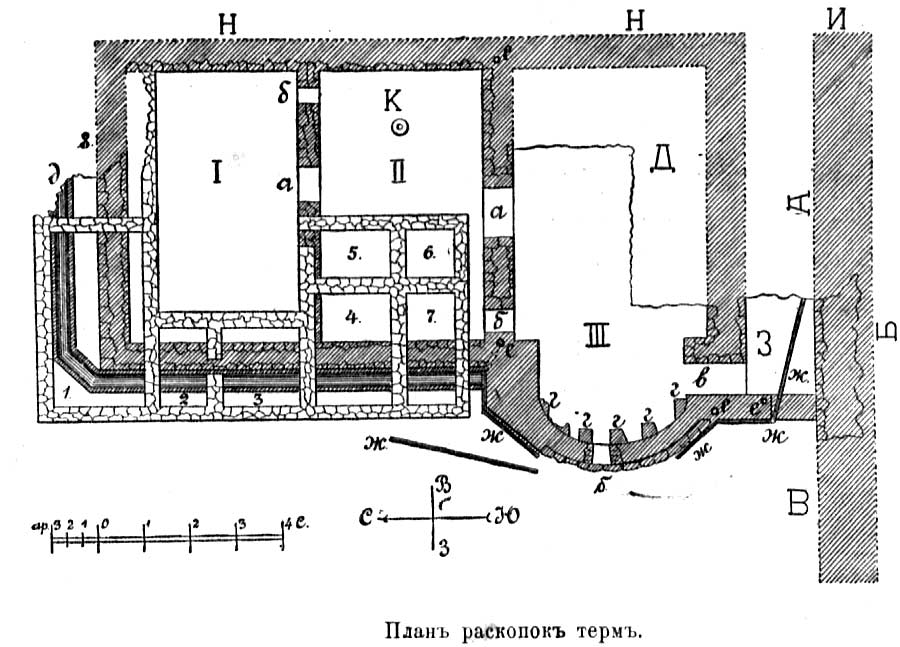
|
| Fig. 13 |
This excavation started from the north-western corner, from room no. 1 (see its plan on p[age] 13), and discovered a part of offlet, nobody knows where it come from, which was carved into bedrock along the distance of 14.93 m and, further, along the distance of 10.67, was constructed of stone with opus signinum, and finished where the main building started to curve.
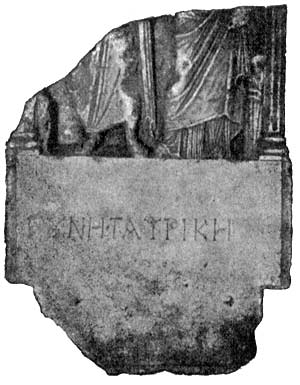
|
| Fig. 14 |
Channel д is of solid work: it is faced with slabs from sides and on top. Outer wall of the thermae goes parallel to the channel; this wall is preserved to a low height; it was constructed firmly, with lime. Two transverse walls, each with door а and vaulted gap б at the same level as the door, divide the building into three spacious rooms (I, II, and III), obviously of the ground floor, with floors in opus signinum, of which the floor in the third room is distinguished with its thickness and solidness. Big pithos К was buried into ground up to its very neck in the middle of room II; it is considerably cracked. Above the walls of rooms I and II, which are preserved to a low height, an entire block of the upper city was constructed in the Late Byzantine period, as one can see from the discovered rooms 1-8. According to the lack of doors and windows, the latter rooms were cellars to which it was necessary to descend probably through a hatch in wooden floor of upper living room. The same location of buildings is preserved well in the area of the ancient city uncovered neighboring the warehouse of antiquities. When removing soil and stones from rooms nos. 1-8, a great number of bottoms and potshards of glazed ware was discovered; now one can consider quite proved that this ware appeared in Chersonesos very late (evidently not earlier than the 12th c.) [26].In room no. 1, the inner space of channel д was filled by scales of big fishes. At the eastern wall, at rocky wall base, 2 fragments of a big marble grave stele with perfectly carved relief (fig. 14)were found: in portico, upper part of which has not been found, between two fluted columns with typical Roman high bases, 4 figures are depicted standing:
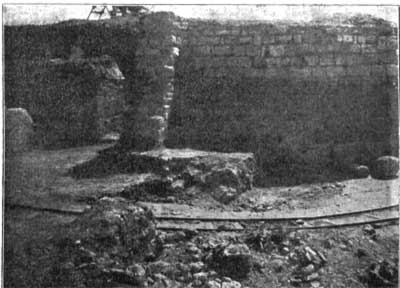
|
| Fig. 15 |
- of a man, with his right hand supporting the cloak, though the left one is down and holds a roll;
- of a woman in long cloth beautifully falling with multitude of folds;
- of a girl, to the left;
- of a boy to the right, both leaning on columns.
The upper part of the men's figure is broken off and uncovered in considerably damaged state, 2.85 m fare from the big fragment [27]. Top part of woman's figure, fragment of the left column, and pediment were not found. The existence of the latter is evidenced by, apart from the columns of portico, 2 holes for pirons upper than the man's head. One-line Greek inscription is located below the figures [28]. Western wall of the main room III, which architecture is especially interesting, is a semicircle similar to temple apse, with vaulted window (0.84 m w[ide] outside and 0.75 m inside). The height from the floor in opus signinum to the place where collapsed vault started is 1.06 m. The wall is constructed in beautiful way, of dressed rubbles with alternating courses of bricks above thick layer of lime ((s[ee] fig. 15)).
The wall is preserved to the he[ight] of 2.13 m and w[idth] of 0.80 m at this place. This rounded part is adjoined, from inside, by 6 supporting pillars г - г that are constructed of bricks (0.58 m long, 0.24 m w[ide], and 0.09 m th[ick]) looking like they were prepared especially for that purpose. First two pillars from the n[orth] are heavily damaged, the others are preserved better. Vaulted apertures б - б in two transverse walls are called windows because of their inconsiderable width of 0.71 m and 0.89 m and height of 1.06 m from the floor in opus signinum to the place where the collapsed vault starts, in contrast to holes а - а that are 1.42 and 2.13 m wide and are called doors; it is most likely that these windows in walls between rooms of the lower story could not be used for daily light in the thermae, similarly to the high and quite typical window in the semicircular wall, and had another, still unknown, purpose.
Marble basin laid in room III, on the floor that is considerably damaged in that place; it was 1.25 m in diameter, 0.53 m h[igh], and with walls 0.26 m th[ick], broken into 4 pieces looking like it fell from above. Narrow passage (1.25 m w[ide] and 2.85 m long) with side walls preserving to the height of 1.06-1.78 m leads from that room, from the southern side, in the direction to the defensive wall И, which keeps its inner facing of stone slabs here. The passage finishes by vertical wall, 3.20 m fare from the defensive wall. Empty space З between the latter and the southern wall of the thermae is a hollow with friable soil. Through this embankment, with sloping toward defensive wall, a line of water pipes ж - ж (up to 0.49 m long and 0.12 m in diam[eter]) is laid, part of which is discovered at the socle of rounded room III, as is indicated on the plan. Second line of pipes went in front of the curved wall passing within close distance of the first one, but it was destroyed when deepening the road, which was arranged through the breach in defensive wall И in 1885 (10 intact and 21 damaged water pipes have been extracted from there). In the collapsed wall of the main room III, in 4 its parts е - е, pottery pipes (0.18 m in diam[eter]) were laid, probably from the upper story, with inconsiderable incline: eastern one to N[orth]-E[ast], north-western one to N[orth]-W[est], and 2 south-western ones to W[est]. Broken into pieces capstone of well laid in the eastern corner of still not investigated part of the same room (Д); it was rectangular (0.89 m long, 0.80 m w[ide], and 0.67 m h[igh]) and had circular hole (0.62 m in diam[eter]) carved into it, atop of which, as it appears from the cuts that survived, there was hinged lid. Front wall of the well is heavily worn in 3 points by rope when getting water, from which circumstance one may infer that above the well there was no appliances like those used at present. Besides the walls with courses of brick (similarly to the walls of baptistery at Uvarov basilica) as described above, solid floors in opus signinum, marble pool, carved into bedrock offlet, and entire system of pottery water pipes, improvement of the thermae is indicated also by found in excavations 14 thin and narrow marble cornices, 18 fragments of marble slabs, and 135 fragments of thick window glasses.
The narrow strip of land to the west from the thermae, from building no. 1 to the defensive wall В, was uncovered down to bedrock and appeared to be a part of a square or a street. In soil taken away from there, apart of glasses mentioned above, 95 fragments of glass pottery (bottoms, handles, and necks of bottles, stems of wide goblets, and fragments of flat vessels) were found.
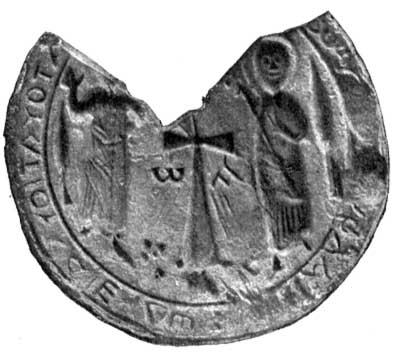
|
| Fig. 16 |
The main defensive wall И that adjoins the thermae from the south was heavily destroyed in 1885 when paving the road there, but it keeps slabbed facing at its inner side. The following antiquities have been found, apart from the described above, in course of the excavations in this area of the ancient city:
- fragment of marble slab with four-lined Greek inscription [29];
- another, damaged by fire, fragment of marble slab with remains of 12 lines of Greek inscription [30];
- bottom of big red clay plate with letters NHK scratched on its outer side;
- fragment of tile mould for casting small icon or relief imprint shaped like flat circle (fig. 16) with incuse images of big cross with two saints standing at every side, cypress trees on each side, and carved mirror image of Greek inscription along the border [31];
- fine slate mould for casting small circular icon or amulet with eyehole and plate with longitudinal line and triangles on one side (fig. 17a) , and from the other side - (fig. 17b) of cross decorated with circles and shell-shaped pendant;
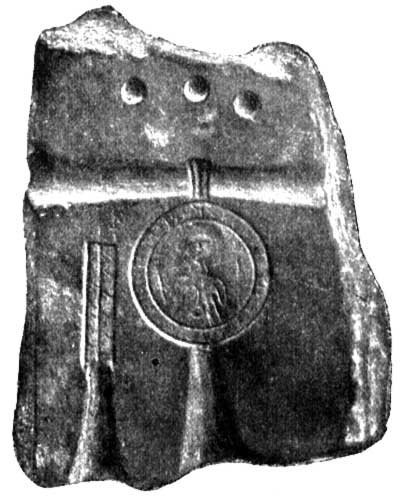
|
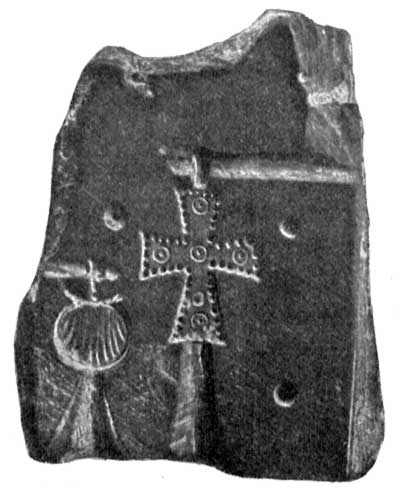
|
| Fig. 17a |
Fig. 17b |
in the small icon, there is half-length image of male figure with crosses in raised hands, and corrupted Greek inscription around the image: "Lord help to the one who bears. Amen" [32]. For casting, two other pieces, which are not found, were attached to the discovered plate on every side; to fasten together, there were pins in edge plates, though the discovered one has corresponding holes; conic grooves are cut for pouring metal in;
- fragment of marble statue of lion attacking bull from behind, with a beast similar to rat, between two turtles, below (lion's and bull's heads are missing);
- marble base (0.2 х 0.2 х 1.15 m), on top of which, at the background, a kind of log of big tree is visible, and in front of it and back to it, lower parts of two naked men (one of them rests on his right knee; only few remains preserved of both figures, from which, however, one can understand the position of legs);
- worked marble similar to horse's head, considerably damaged (0.18 m wide), which was not broken off the statue of full-length horse, but makes a special separate decoration perhaps for the horse tomb;
- 18 potsherds of fine clay black-gloss ware;
- fragment of small clay vessel similar to the one uncovered in 1896 in the area at the new church, shaped like a candlestick with short but wide neck, handle and round hole at the base, perhaps an icon lamp of the Byzantine period;
- fragment of top part of very large patera with appliance for pouring out liquid;
- fragment of cl[ay] narrow-neck handless vessel;
- cl[ay] lamp with roughly made image of vase;
- 3 top parts of cl[ay] lamps with relief images of vine on the first, Eros stepping left on the second, and running beast with highly raised fluffy tail on the third;
- cl[ay] lamp without images but ribbed;
- big clay lamp of extremely rough treatment;
- top part of cl[ay] lamp;
- seven cl[ay] plain lamps, of which 4 are made quite roughly;
- cl[ay] lamp with cross-shaped handle [33];
- part of big bowl under light-yellow glazing with squeezed contour of monster bird (careless strokes of green and brown paint are made on top of its head, neck, wings, tail, legs and below on flower);
- bottom of fine cup under light-brown glazing, with roughly made contour, probably of scorpion, above it;
- 7 fragments of big light-green plate with brown contour of monster bird;
- 3 fragments of glazed bowls with unskilled images of parts of birds made by brush;
- potsherd with green glazing decorated with lines of alternating big and small relief rosettes;
- 1,346 bottoms, necks, handles and other parts of cl[ay] pottery with multicolored glazing but without images;
- 4 fragments of blue glass vessel with aureate decorations of which some look like a cross;
- fragment of glass vessel bottom with conic stem, unfortunately broken, raising from the middle of it;
- fragment of glass vessel lid with circular button in the middle;
- cup of sheet bronze with 2 holes to which arc[-handle]s were fastened;
- marble mortar, damaged;
- fragment of marble mortar;
- 3 fragments of stone mortars;
- 2 quernstones for hand mills;
- br[onze] folding key;
- 3 whetstones for knives;
- fragment of small br[onze] bell;
- 8 throwing stones;
- fine br[onze] weight, shaped like flat circle, fine chiseled (the smallest one in set of weights);

|
| Fig. 18 |
- 3 br[onze] fishhooks;
- 9 cl[ay] sinkers for fishing nets (8 pieces in the form of truncated pyramid and 1 ball-shaped);
- stone sinker shaped like flat circle;
- 2 br[onze] needles for knitting fishing nets;
- two bone awls of which one has flat handle;
- 4 clay balls;
- thick glass broken in the form of hexahedron and used perhaps as a toy;
- silv[er] buckle, flat, oval, decorated with circles with dot in the middle;
- silv[er] bezel of finger-ring with round green glass [jem];
- carnelian cut pierced bead;
- 10 fragments of multicolored glass bracelets;
- pendant of blue glass paste in the form of knucklebone;
- fragment of br[onze] plain cross decorated with circles with dot in the middle;
- 5 bricks of square form;
- 2 pieces of marble of dark green color with light green spots;
- piece of sulfur;
- lead rod;
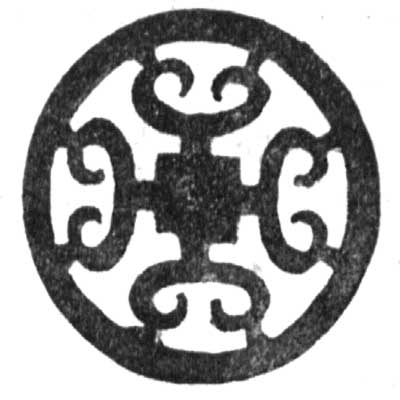
|
| Fig. 19 |
- fragment of limestone grave stele with extremely rough image of naked warrior standing facing spectator with spear in his raised upper hand and shield in his left hand down; his long hair is tied on top and divide into 3 tresses (fig. 18);
- domestic goat's horn;
- 8 cut away top parts of wild goats' horns;
- cut away top part of deer's horn;
- 3 tusks of wild boars;
- bottom part of a big spiral shell;
- 2 br[onze] circles of fine work (fig. 19), which greatly suffered of oxidation [34]; in the round hole located in center of one circle, fragment of iron rod is preserved, which probably fastened both circles together similarly to an axle; both circles are slightly bent;
- cl[ay] circle with hole, carved of potsherd with brown glazing;
- a kind of clay plug for amphora with 4 side, located in parallel, holes and vertical deepening on its top;
- coins of Chersonesos (of Romano-Bosporan period and Byzantine period: of Justinian I, Basil I, Leo VI and Alexander, Romanus I, Constantine I and Basil II), and of other Greek colonies (Agrippeia and Pantikapaion), also of Late Roman and Byzantine emperors.
IV. Accidental excavations and chance finds
When the monastery was constructed cess pit in the very corner formed by the defensive wall and the new hotel
(s[ee] fig. 20)
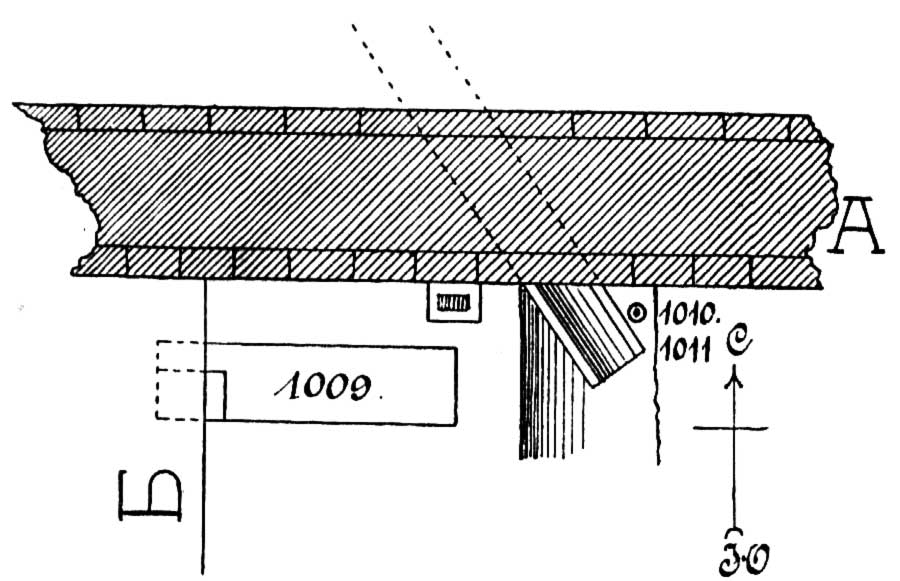
|
| Fig. 20 |
25 m fare from the monastery gate, big and solidly constructed of slabs tomb (no. 1009), covered with 2 layers of slabs and coated with opus signinum from the top, appeared 3.2 m deep below the ground surface. This tomb (3.55 m long, 1.06 m w[ide], and 0.90 m h[igh]) was located 0.71 m fare from defensive wall А, so that the new monastery hotel (let[ter] Б on the ground plan) occupied 0.35 m of its western part. From this side, in the south-wes[tern] corner of the tomb, slabs separated rectangular space (0.53 m long and 0.35 m w[ide]), inside of which there were: 3 urns (lead one, completely destroyed by the time, and 2 cl[ay] with one handle); bones of one human skeleton; cl[ay] one-handled ewer; damaged cl[ay] cup, one-handled and ribbed; broken cl[ay] saucer; 5 cl[ay] lamps (of which 2 are plain, 1 with rosette of 14 petals, 1 with slightly convex image of bearded head decorated with horns, and 1 with image on phallic theme) and bronze, worn off completely, with countermark of Chersonesos (staying Artemis), reproduced at Burachkov's on pl[ate] XVI, № 120.
Amidst the fired bones fallen from the lead urn there were: gold hollow finger ring with oval plain glass; 6 gold badges with holes for hanging (2 of which are circular, with images of stars, and 4 shell-shaped); 5 pieces of thin sheet gold, and crushed glass round-bottomed balsamarium.
Two clay one-handled urns contained: the first one 4 pieces of thin sheet gold and broken iron athlete's scraper and the second one 6 pieces of thin sheet gold and bronze belt buckle.
12 urns more laid and stood at the walls of the tomb: 6 clay one-handled and 6 lead ones, of which 5 (handleless) fell to pieces, so only bottoms and lids remain, and the 6th, the big one, ball-shaped and with mushroom-shaped lid, although was damaged by the time but could be transported to the warehouse of antiquities. This urn neck and corresponding parts of the lid have 2 circular holes each for fastening the lid. This urn contained: gold finger-ring, of fine work, with circular convex glass; gold badge with imprint of eyelet and 4 holes for hanging; 5 pieces of thin sheet gold; glass flat-bottomed bottle and 8 beads (4 ribbed ones of green glass paste, 3 elongated ones of blue glass, and 1 of jetstone in the same form).
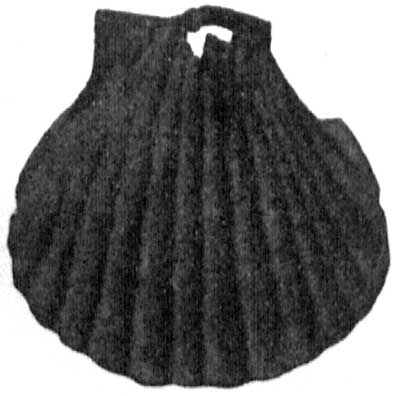
|
| Fig. 21 |
Five damaged lead urns of simple form (s[ee] 1891 Otch[et] Arkh[eologicheskoy] Kom[missii], p. 147, no. 182) contained:
- The 1st one: gold finger-ring with 2 sockets, circular (convex garnet is mounted in it) and oval (gem fell out of it and was not uncovered); fragment of gold children's bracelet or big earring with egg-shaped glass and eyelet; glass round-bottomed balsamarium; sil[ver] shell of artistic quality (fig. 21) and br[onze] coin of Chersonesos with image Apollo's head on one side and letters XEP within wreath on the other (s[ee] catal[ogue] by Burachkov, pl[ate] XVI, no. 91).
- The 2nd one: two gold pendants in the form of plates with two eyelets on every end, decorated with granulation, border of balls and fine round light-blue glasses [35]; 6 pieces of thin sheet gold and phallus-shaped pendant of green glass paste.
- The 3rd urn enclosed: 4 pieces of thin sheet gold, silv[er] broken into pieces headdress pin, which was at the same time used as ear-cleaner, and bone crushed ring.
- The 4th urn held iron broken into pieces athlete's scraper and iron blade of knife.
- The 5th one was found with gold hollow finger-ring with oval convex garnet having roughly carved image of perhaps Demeter with cornucopia in her left hand; pair of gold earrings shaped like a cord, gradually thickening and ending with hook (on the thick edge there is lynx's head with hinged to it circular medallion with convex glass of light-blue color);
18 gold badges for sewing on clothes in the form of round-top caps with 2 holes for fastening; component parts of two gold bracelets (26 ribbed tubes of different size that were connected to each other and were located symmetrically, and 26 narrow plates of the same ribbed tubes but of the same size); necklace consisting of 2 gold cords with wire hinges on top and of hanged to the cords and connected by hinges 9 gold oval medallions of different size, framed with border of balls, with inset of 7 convex garnets and 2 glasses of green color; each medallion has also additional hinges from the third outer side, to which pendants were perhaps fastened, of that only 3 pieces survived, namely 2 of gold badge in the form of trihedral arrows with two medallions with green glasses and 1 of the middle, the largest medallion in the form of butterfly decorated with border of balls, round convex glass of light-blue color on the head, and egg-shaped convex garnet on the left wing; stones from the other 2 egg-shaped sockets (on the right wing and on the abdomen) are missing and were not uncovered, the same as 6 other pendants, in spite of the fact that the soil taken off the tomb was accurately sieved though a kind of tin hand-sieve. The missing parts were probably damaged by fire when the corps was cremated and were not put into the urn. Thin chains with sectional links went from the butterfly's wings to medallions on the left and on the right. The necklace bears traces of long-term usage, which is especially visible on the hung butterfly where the old damages were restored carelessly, and on one of medallions with green glasses. All medallions were connected to each other with not a golden wire as of the necklace from tomb no. 630, but with silver one which perished and became purple-colored; this way, the medallions laid on the bottom of the urn mixed with other jewels and bones [36].
In 6 one-handled urns, two of which appeared crashed, there were: 26 pieces of thin sheet gold; broken gl[ass] flat-bottom balsamarium; 2 iron broken to pieces athlete's scrapers; 3 iron blades of small knives; stone hone with hole for carrying; 3 br[onze] belt buckles and fine br[onze] spade broken into pieces.
Rectangular slab of hard local stone (0.71 m long, 0.35 m w[ide], and 0.4 m h[igh]), which is smoothly cut from one side and decorated with cornices on 3 sides, on top, on bottom and in the middle, stood in between of tomb no. 1009 and defensive wall А leaning on the latter. Its face has a hollow down to 0.06 m deep on the example of the miraculous stone decorations of children's gravestones that were obviously intended depict head and shoulders and were uncovered, in great number, together with lower slabs in excavations of necropolis on the shore of Karantinnaya bay in 1896 and 1897. On top of the monument, elongated trough was chiseled down to 0.09 m deep, so that the left long side is steeply cut off and the right rounded side is aslant. The cut in the face side is made carelessly, so it crosses the medium cornice, which is indication that this stone was fit for gravestone in a later, however pre-Roman, period
[37]. It is interesting that the artisan tried to represent top decoration of the tombstone, that is human head and shoulders, and also carved the part from below to be used for fastening in horizontal slab and that is why would not be visible.
At the distance of 1.06 m eastwards from the tomb, thick stone slab, 0.71 m w[ide], chiseled as groove-shaped semicircle, projects from defensive wall А being inclined to the bedrock and with deflection to the south-east. At place where the slab goes through the wall, the latter is constructed like an arch, which, together with hollow in the slab, forms circular stone drain pipe 0.44 m in diam[eter]. Under the slab, from the very wall towards the gully, a shallow channel of irregular form was cut in rocky wall base. Here, the soil appeared wet; it proves that, after heavy rains, the water from the city-site comes by the ancient channel till now.
Clay one-handled urn was discovered under the channel slab, and another urn of the same form and size was a bit to the left (nos. 1010 and 10.11). Because the urns were not covered with clay plugs, soil penetrated inside; when taking it away, an iron broken into pieces athlete's scraper and 3 narrow iron leaves with hooks on each end were found in every urn. The urns did not contain fired bones.
Children's bronze bracelet with pointed tips and bronze ribbed pierced bead put on it was discovered near the tomb, in soil of the embankment; therefore, it became clear what was the function of such pierced beads that are often found in graves and are absolutely similar by their from with ribbed beads of green glass paste.
The coastal defensive wall, where it approaches the bay very closely, in between of the wharf tower and monastery fence, a hollow developed after heavy spring rains, rectangular in its upper part, that appeared to be latrine (1.73 m l[ong] and 0.98 m w[ide]) carefully laid of big stones hewn from each side [38].Now there is now doubt that the coastal wall and towers approached the present Karantinnaya bay in this area, the same as in front of the warehouse of antiquities and lower than captain Belozorov's home; then this wall, from N[orth] and S[outh], inclines towards the main wall А leaving large coastal area open for it may be used for unloading and storing goods.
In the north-west[ern] corner of the ancient city, in the area most remote from the warehouse of antiquities, unknown criminals who deals with stealing stone to sell it in Sevastopol broke marble doorstep off the tomb with brick vault under the minor church discovered in 1891. The doorstep was already put down from the high shore to the sea obviously in order to transport it by a boat in good weather and sell to marble-dealers. The workers found this doorstep and carried it to the warehouse of antiquities; it appears to be a part of ancient pedestal of white marble 0.81 m long, 0.22 m wid[e] and 0.126 m thick. Its flat top side keeps traces of saw. Hollows for the left foot sandal and spear, sword or another support remain on the right side of the lower part of the doorstep; they were considerably damaged when dressing the slab. Polished surface of the transverse side keeps a part of Greek inscription of 5 lines in olive wreath, lower part of which was destroyed together with the lowermost line of the inscription when sawing the stone. This inscription, however, has nothing to do with the statue traces of which remain on the stone, because the letters are upside down in relation to that part of pedestal. This implies that once another statue stood on the other side of the stone or, in other words, the stone had been used for pedestal twice before it was clipped and used for a doorstep [39].
|












